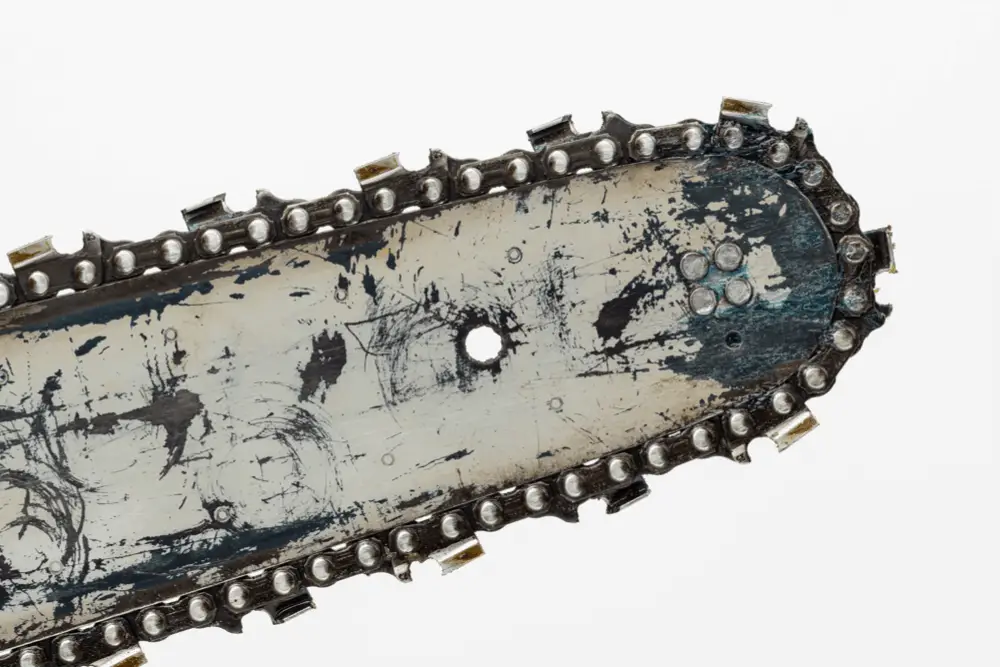A chainsaw is an indispensable piece of equipment on the homestead, and it makes life easier for processing large stacks of wood in a short time. Even though it is a great time and labor saver, it is a machine, and like all machines, it suffers from wear and tear. So how do you know when your chainsaw chain is worn out and when it needs to be replaced?
Symptoms that are indicative of a worn chainsaw chain and may require a replacement.
- The chain burns the wood.
- The chain can’t be tensioned.
- There are teeth missing.
- Difficult to align the saw when starting a cut.
- The chain is chipped.
- The saw vibrates in the cut.
- Chainsaw does not cut evenly.
Many people who are new to chainsaws are unfamiliar with their maintenance and signs that the chain is wearing out. It is worthwhile to take note of the symptoms of a worn and inefficient chainsaw chain because a worn chain will not only be inefficient but can also pose a danger for the chainsaw operator.
Signs Of A Worn Out Chainsaw Chain
When you consider the type of work that a chainsaw chain does, you would expect that the chain would wear out more often than it does. Even though the chain lasts a long time, it will eventually get to the point that it can no longer be sharpened or has sustained sufficient wear and damage that it needs to be replaced.
How can you tell that your chainsaw chain has reached this point of no return and needs to be replaced? There are some specific signs you can be on the look out for that will give you an indication that your chain is beginning to reach its end of life.
- The chain burns the wood. If there is smoke coming from the cut as you use your chainsaw, it could be an indication that the chain needs sharpening, but it could also mean the chain has too much friction because of wear and tear and needs replacing. Sharpen the teeth n the chain, but if this does not help, replace the chain.
- The chain cannot be tensioned. If the chain tensioner is at its maximum and the chain is still too slack, it means that the chain and its links have stretched to the point that it can no longer be tensioned and should be replaced. A slack chain will also result in the chain jumping off the bar easily.
- There are missing teeth on the chain. If the chain has teeth missing, it will not cut efficiently, and it will cause a build-up of heat due to the friction. It will also be difficult to cut through the wood.
- The chainsaw moves around when starting a cut. When you first place the chain on the wood to initiate the cut and the saw jumps on the wood and makes it difficult to place your cut correctly, the chain could be worn and in need of replacement. Be careful with this symptom because it could also indicate a worn-out bar.
- The chainsaw does not cut easily, even after sharpening. If the chain has been sharpened and still struggles to make the cut, then you may need to replace the chain.
- The chain or the teeth are chipped. If the chain has sustained damage by inadvertently hitting stones or other hard material once you complete your cut, it may chip the teeth or even the links of the chain itself. This will cause the chain to hook and catch in the wood and generate additional heat from friction. If your chainsaw chain is in this condition, replace the chain.
- The saw shakes and vibrates in the cut. If the chainsaw is unstable or has excessive vibration while making the cut, the chain may need replacement.
- Uneven cuts through the wood. If your chainsaw does not make straight, even cuts, it could be a symptom that is pointing towards your chain needing replacement.
These signs are definite indicators that you need to get your chainsaw up on the workbench and have a good look at it to check for wear and to see what you can do to remedy the situation. Sometimes it is not only the chain that has suffered wear and tear and is in need of attention.
The Chainsaw Bar
The symptoms that we have mentioned as indicators of wear on the chain of the chainsaw could also have an associated cause. The chain on the chainsaw is not the only component that experiences wear during the operation of the tool.
The chainsaw bar is the part that the chain runs around. This component has a groove within which the chain runs. The chain needs to fit snugly within this groove with minimal lateral movement in this groove. As the chain runs in the groove, it wears the sides of the groove and widens it out.
When the chain groove becomes too wide, the chain wobbles in this groove and can produce some of the symptoms that we have mentioned.
If your chainsaw is experiencing any of these signs, we would recommend that you take a look at the chain and the chainsaw bar at the same time. There is no point in buying a new chain and fitting it to a worn-out chainsaw bar. This will cause unnecessary and faster wear of the new chain.
It is not always necessary or required to replace the bar every time you replace the chain, but it is worthwhile checking it for wear each time you replace the chain.
Factors That Damage A Chainsaw Chain
There are contributing factors that will make your chainsaw chain wear out faster than normal and require replacement more frequently.
- Hitting rocks or the chainsaw digging into the ground after a cut.
- Nails embedded in the wood will break chainsaw teeth and damage the chain.
- Lack of appropriate lubrication with a good quality lubricant will cause the chain to wear faster.
- Rust on the chain will cause rough spots on the chain which will hinder its efficiency and generate more heat. The rust is usually a sign of improper cleaning and oiling of the chain or improper storage of the saw.
How Often Should You Change Your Chainsaw Chain?
A chainsaw is a tool that takes quite a lot of abuse, but most chainsaws are built to withstand this rough work and are built to be tough and durable to withstand the heavy work.
Surprisingly, with the correct maintenance and care, a chainsaw chain can last you in excess of 5 years with regular use. If your use of the chainsaw is only moderate use, your chain on your chainsaw chain could last you a decade or more.
The frequency with which the chain will need to be replaced will depend on the frequency of use of the chainsaw and the maintenance that is done on the chain. Simple maintenance tasks such as regular sharpening of the teeth on the chain, the correct tension on the chain, and regular lubrication of the chain will help to extend the life of the chain.
The Dangers Of A Worn Chain On A Chainsaw
A worn chain on your chainsaw will not only make it difficult to perform the cut, but it has some other side-effects which you may not have considered.
The worn chain will make your chainsaw work harder to get through the cut, which will, in turn, put unnecessary strain on the motor of the chainsaw. This additional strain on the motor will cause damage and result in the need for more frequent maintenance on the engine.
Even worse than the damage to the motor, a worn chain can make your chainsaw more prone to kick back, which happens when the chain binds in the cut and causes the saw. The danger is that with a saw that is not cutting efficiently, you lean more into the cut with your body, putting you in a dangerous position should kickback occur.
Conclusion
A chainsaw is a useful power tool, but it is also a dangerous piece of equipment. As with any power tool, it is good safety practice to make sure your tool is in optimal operating condition at all times. For a chainsaw, this is the chain and the chain bar.
If your chainsaw is showing any of the signs that we have described, it would be prudent to give your chainsaw some attention and establish the cause of the symptom. It is certainly not worth the risk of going ahead with the job if your equipment is not in good shape.
Always keep a new chain tucked away in your workshop as a spare so that you have one available when you need a replacement.

